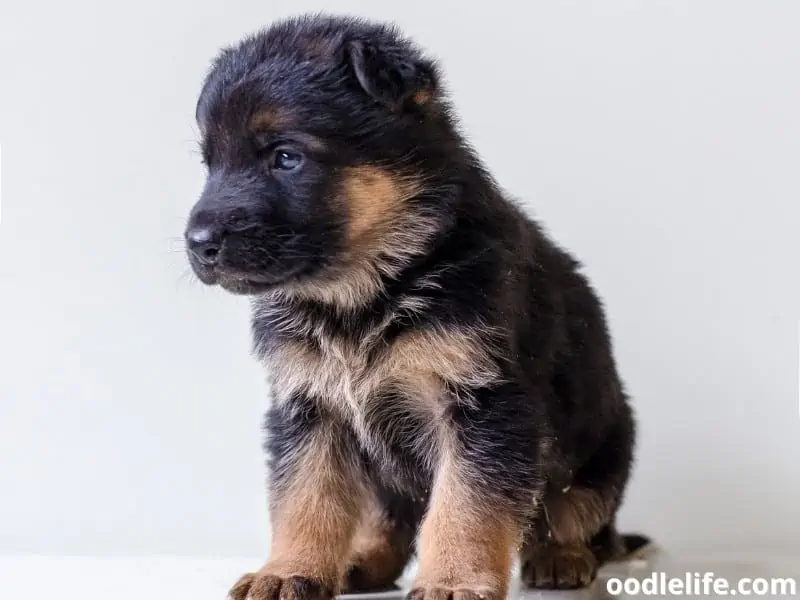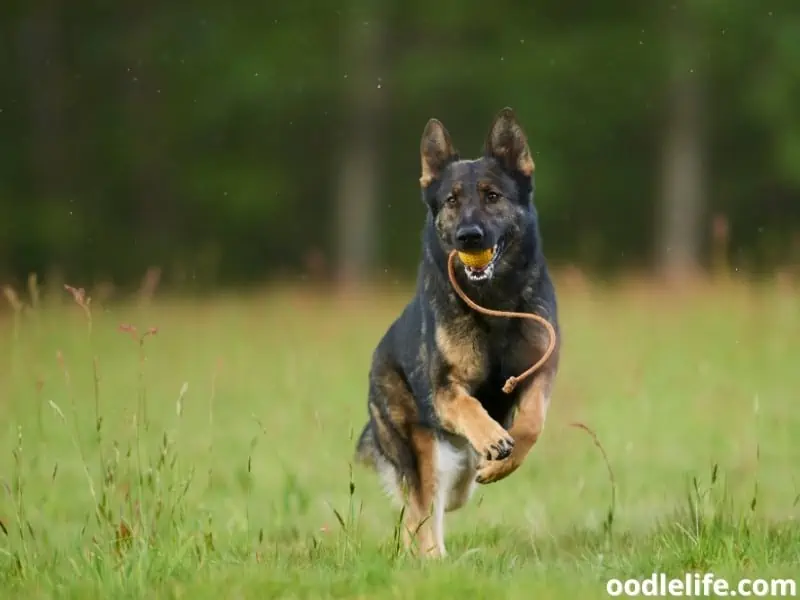When Do German Shepherds Stop Growing?
If you’ve recently taken your German Shepherd puppy home or you’re even looking to buy a new addition for the family, knowing what you’re getting and what to expect is important.
You can do all the research you want, and plan for if you want a long or short-coated dog based on the amount of free time to groom them you have. One thing you can prepare for but can’t entirely guarantee is the size your little bundle of fluff is going to be.
If you think of people as an example, you can have a family of varying different builds and heights based on a long line of genetics.

Both of your parents may be tall but then you may not be, this can be down to other individuals in your family tree that incorporate into your DNA.
Similar things can happen with dogs, you can plan the best breeding and predict with reasonable accuracy how big or small the puppies will be but there may be a few that surprise you or a whole litter that does. It’s not always the most accurate, just good guesswork so you have to be comfortable with some variation.
Kennel Club Breed Standards
The Kennel Club standards state that the average height and weight of a German Shepherd is slightly different for males and females.
- A male German Shepherd is on average between 24 and 26 inches tall while weighing 71 to 84 pounds.
- A female German Shepherd dog is usually smaller and between 22 and 24 inches tall, weighing between 62 and 68 pounds.

The biggest difference between the two generally is how much they fill out. While there are a few inches between them, males tend to be stockier and thicker in the shoulders than their female counterparts.
Your puppy’s lines are important in predicting their final height and weight. German Shepherds tend to have two different lines, the show standard dogs and then the working dogs. Show standard dogs are a little leaner and tend to have a sloped back end that angles towards the ground.
Working lines of German Shepherds are more straight-backed and tend to be quite a bit stockier so they have more muscle. They can grow a little larger and can weigh significantly more.
Puppy Developmental Stages
The puppy stage can last anywhere between five and six months but for larger breeds like the German Shepherds, it usually lasts six months. Larger breeds of dogs need longer to develop and mature than smaller dogs. Smaller breeds will reach their full size often within the first year while German Shephards take longer to stop growing.

From when they’re born through to about 2 weeks of age, puppies are very small and helpless. They only have the ability to taste and touch so they can find milk but rely entirely on their mother. A newborn puppy will be between 3 and 6 inches and still have plenty of growing to do until they are fully developed.
Between then and 2 months of age, a puppy will double in size and their senses will continue to develop. Their eyes will open and their motor skills will get increasingly better so they can explore their environment more. This is the period where they will start to develop their personalities.
They’ll learn to walk, bark, and play fight with their siblings. At this time, there is usually a size difference between the litter mates that becomes more apparent as they grow.
The bigger ones at birth will often be able to muscle in and get more milk so they develop to be a little larger and stronger than the rest of the litter, while the opposite is true for the smaller puppies.
When puppies leave their mother at 2 months old, their next month is filled with a lot of changes as they usually go into their new homes. This is when a litter may be given different food, and different routines and environmental changes may have an impact on their growth rates. This puppy stage will last until 6 months of age when your puppy will learn to develop and bond with your while growing.
At this age, they may seem to get taller practically overnight as they can grow quite rapidly. By the time they reach 6 months they can be between 15 and 18 inches tall.
Adolescent Developmental Stages
When a German Shepherd puppy reaches 6 months of age, they become an adolescent. This can be a particularly challenging period for both owner and dog. From an owner’s perspective, you have a dog that is growing larger by the day when they suddenly hit adolescence.
You may notice they start to test boundaries more and you may have spent the last few months perfecting their recall only to have it go right out the window and have to start from scratch.

You’re not alone though, this period is also a challenge for your dog. They’re still going through lots of changes, both physically and mentally. It’s just like becoming a teenager and they’re flooded with hormones in much the same way.
Between 3 and 6 months, you might notice that your dog gets much taller but doesn’t seem to put on too much weight. It’s not abnormal for dogs to look a little underweight during this period and you may have to up their calorie intake.
Sometimes dogs even have growth spurts that leave them with their rear taller than their shoulders but over time, this should balance out.
A good diet and not overdoing exercise are vital during this period to make sure their bones and joints are growing well and not being overly stressed during their bouts of zoomies.
Adulthood
Smaller breeds of dogs will reach adulthood between 1 and 2 years of age but larger breeds need more time to develop and will continue to grow until around 18 months of age. At 18 months, it’s rare for dogs to grow more as far as their height is concerned however you still may notice developmental changes.

As they mature into adulthood, they will gain weight and muscle which means they may finish up taller and significantly heavier because of that muscle.
At 18 months your German Shepherd could be 60 pounds but by two years they can easily be up to 80 pounds. While their bones are growing, they don’t tend to put on much muscle mass so during their adolescent period they may appear quite tall and lanky.
Once their bones stop growing and they reach adulthood, they only usually fill out from there so their weight may change drastically and their height doesn’t alter too much.
Environmental Factors
While genetics plays the most important role in predicting how big or small your puppy will grow, there are some external factors that can help your dog grow up fit and strong as they develop.

Nutrition plays a vital role in the development of young dogs and getting that balance right is going can play a role in bone and joint health as well as how they grow. If you’ve ever seen a malnourished dog that has grown up in a poor environment, you might notice they’re smaller than you would usually expect.
This is because the nutrients they should be getting through their diet are not available and so they don’t have as much support to help and develop as they grow. Dogs with a poor diet can have a lot of issues later in life.
A puppy will need a diet specially developed for their age as younger, growing dogs will need a higher protein content than an adult dog diet that is no longer growing. It’s important to also consider exercise as you need to provide enough calories for your puppy to exercise but also continue to grow. Only providing enough calories for their daily activities will mean they won’t have enough left over to grow big and strong.
There are a range of supplements you can provide your puppy in their diet to help with growth and making sure you’re giving them the best shot at reaching their full size.
Conclusion
Understanding how big your dog is going to grow and when they stop growing is key to balancing their diet, exercise, and maintenance needs. While your dog is growing they need extra care, extra protein in their diet and their exercise should be managed.
If a young dog does too much strenuous exercise there is a chance it will impact their still developing joints.
Knowing the age your dog becomes fully developed will help to protect them against injuries. While the size of their parents is a good indication of how much and how long they will grow, dogs have growth spurts at different ages and like people, there’s always a range in size of offspring so it’s never concrete.
All in all, your German Shepherd will reach their full height and weight by the time they are 2 and a half years old at the latest.